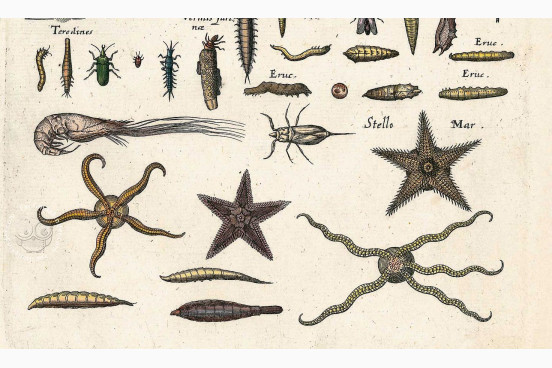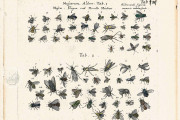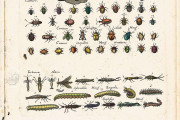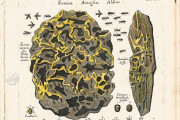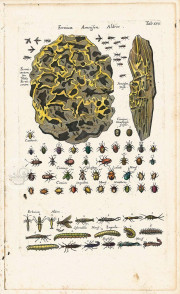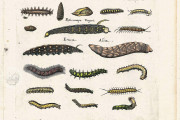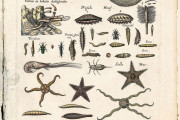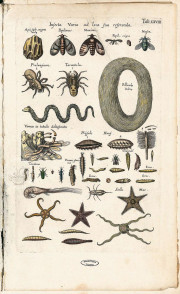In 1603, the great naturalist Johannes Jonstonus (1603-1675) was born in Poland, from a Scottish father and a German mother. This work by Jonstonus (or Josnto) was widely spread and became one of the most successful ones in the 17th and 18th century, it being a reference widely quoted even by Linnaeus (Linneo), among others. It reached several editions in Latin (1657, 1718, 1756 and 1768), and in English (in the very same year of the translation to Latin), Dutch (1660), French (1773) and German (1774).
The Encyclopedia of the Nature
The whole work by Jonston represents an archetypal example of Encyclopaedic compilation of naturalist knowledge. He bases it on authors like Belón, Gessner, Adrivando, Marcgraf, Pison… and other classical authors like Aristotle, Plinio, Teofrastoo, Eliano, Dioscórdes y Opiano. It became a well-known and widely read and quoted piece of work. A great part of its fame and success is due to the wonderful copper-carved plates;which superbly enrich the text and were brilliantly used overall by the great Matthaeus Merian junior.
In 1622 Jonston studied at several centres in Prussia, after that, he visited England and Scotland (collecting already in 1623 valuable information about some British species). After travelling around Germany, France, Italy and Holland, he came back to Britain, to study in Cambridge and London. Afterwards, he graduated in Medicine in Leyden, Dutch city in which he was offered the Medicine chair at University and where he published his first works. Several years later, he was offer the same chair at the electorate of Brandenburg, preferring, however, to continue studying in private and develop his masterpiece: the Historia Naturalis, which would be published for the first time in Frankfurt am Main between 1649 and 1653.The second edition of the work, including trees and plants, would be released in Amsterdam between 1657 and 1663.
In 1655 he came back to Silesia, where, due to his well-earned reputation, he was invited by the Duque of Liegnitz and Brieg. He would die there ten years later, on 8th June 1675.
The Last Great Zoological Work
Jonston’s Natural History is one of the most influential works during a great part of the Modern period and the last great work of zoological encyclopaedias which emerged during the Renaissance. In this piece of work he intends to list, get to know and make known the world of natural things, which was the significance and scope given to these matters in the Renaissance, with a clearly pragmatic use. Jonston, however, goes further than that he searches for the similarities between new thing and things previously known, and he intends this knowledge to be an instrument of education to train the honourable and free man into the construction of a fair and happy world. Hence, he becomes a classic in the field of Natural Science. The reception of the Historia Naturalis by the educated reader of the time was extraordinary.
Written in Latin, language commonly used by science at the time, it gives illustrations a prominent role. It is hardly surprising that such a proposal became a great publishing success with the printing of several editions during the 17th and 18th centuries and its translation into different languages.
The Unparalleled Talent of the Engravers
The artistic lexicon is in the hands of the Merian, a lineage of printers and superb engravers. Matthaeus Merian senior (1593-1650) was the printer and father of the Matthaeus Merian brothers junior (1621-1687), Kaspar Merian (1627) and their sister María Sibylla Merian (1647-1717), the latter from his second marriage to a Dutch woman. Sibylla was firstly an entomologist and a great draftswoman, painter and engraver of plants and insects. However, the most conspicuous artist of the lineage was Matthaeus Merian junior, to whom the Jonston’s most famous copper engravings have been attributed, for in more than one plate of this encyclopaedia we find the legend Matthaeus Merian Junior Fecit (see, for instance, the illustration of the lion in De Quadrupedibus). The composing set design, with some classifying affinity composes a proposal which is even aesthetic, livening up the reading, making the work more attractive and the texts more understandable.
We have 1 facsimile edition of the manuscript "Historia Naturalis: De Insectis": Historia Naturalis: De Insectis facsimile edition, published by Siloé, arte y bibliofilia, 2010
Request Info / Price
